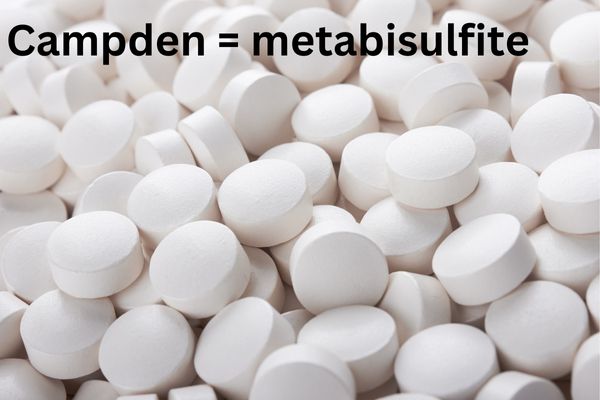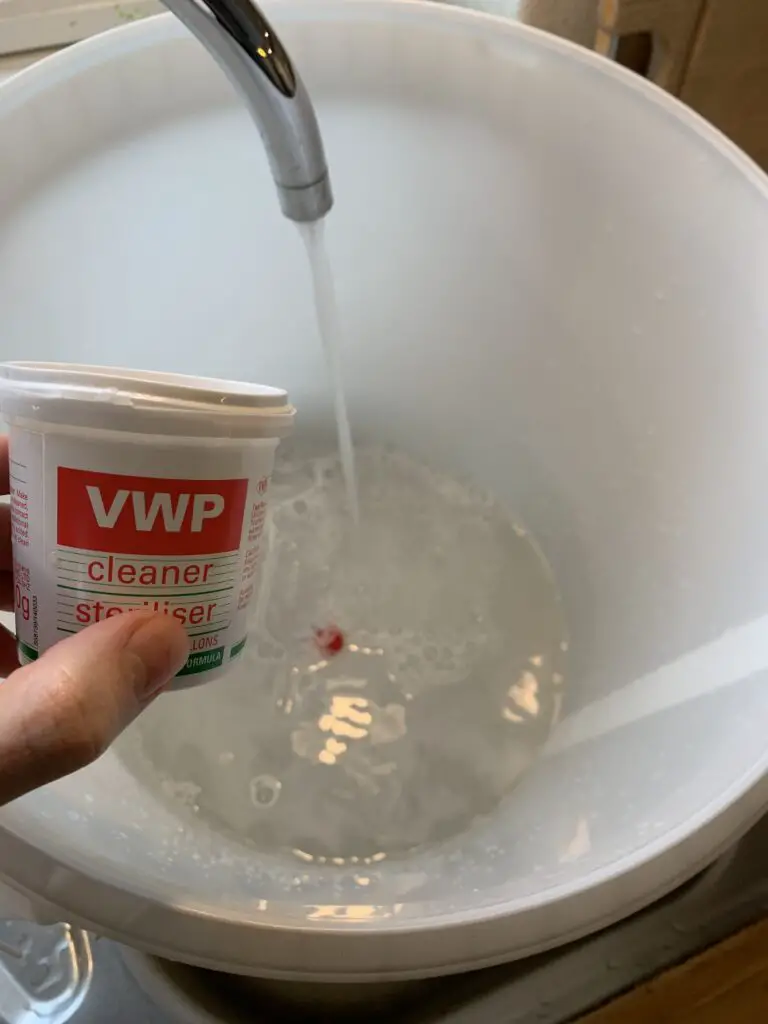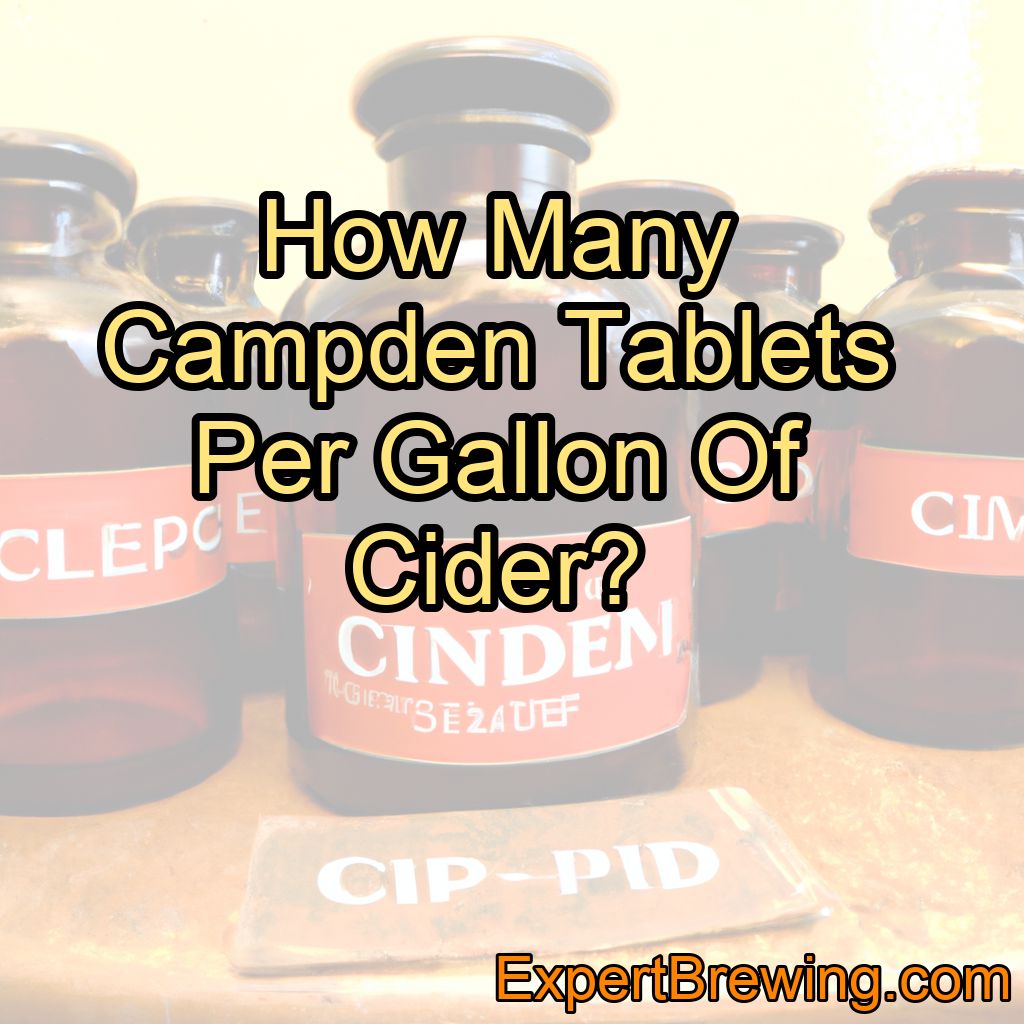Cider making is an age-old tradition that has been enjoyed for centuries. The process of fermenting apples into a delicious, alcoholic beverage has been refined and perfected over the years, with various techniques and additives being employed to ensure the best possible results.
One such additive is the Campden tablet, a popular choice among home cider makers and professional brewers alike.
But just how many Campden tablets should be used per gallon of cider, and what role do they play in the overall process?
In general, use one Campden tablet per gallon of cider. Crush the tablet and dissolve it in a small amount of water, then add it to the cider.
However the optimal amount will depend on the pH, sugar content and yeast type used in your cider brewing.
In this post, we’ll delve into the world of cider making and explore the use of Campden tablets, offering guidance on their application and sharing some personal experiences along the way.
1. What Are Campden Tablets?
Before we can begin discussing the use of Campden tablets in cider making, it’s important to understand what they are and why they’re used.

Campden tablets are small, white, compressed tablets made from potassium metabisulfite or sodium metabisulfite. They are used primarily as a sanitizing agent, helping to kill off unwanted bacteria and wild yeasts that can negatively impact the flavor and quality of the finished product.
In addition to their sanitizing properties, Campden tablets also act as an antioxidant, protecting the cider from oxidation and browning. This helps to preserve the cider’s color, flavor, and aroma, ensuring a more enjoyable drinking experience for the end consumer.
2. Why Use Campden Tablets in Cider Making?
As mentioned earlier, the primary reason for using Campden tablets in cider making is to sanitize the juice and prevent the growth of unwanted microorganisms. When apples are pressed to extract their juice, there is a risk of introducing bacteria and wild yeasts that can spoil the cider.
By adding Campden tablets to the juice prior to fermentation, these unwanted microbes are killed off, allowing for a controlled fermentation process using the desired yeast strain.
Another benefit of using Campden tablets is their ability to prevent oxidation. During the cider making process, the juice is exposed to air, which can cause oxidation and lead to off-flavors and browning. Campden tablets help to protect the cider from these issues, preserving its quality and extending its shelf life.
3. How Much Campden Should I Use?
The amount of campden you use depends on how much cider you are producing and what type of container it will be stored in (bottle/keg).
I am going to repeat myself for your scrolling convenience:
First, it is important to measure the pH accurately before adding any types of sulfites.
For low pH level ciders (less than 3.5), 1-2 campden tablets per 1 gallon will do the trick – this corresponds to 0.44-0.88 grams of metabisulfite per liter of liquid.
If your liquid has a higher pH (>3.5), you’ll need more – up to 3-4 campden tablets or 0.44-0.59 ounces per gallon should do the job in this case too!
| pH of cider | Grams KMS/SMS | No. of campden tablets (5 liters of cider) |
| 3 or lower | 0-0.2 | 0-0.5 |
| 3.1 | 0.44 | 1 |
| 3.2 | 0.7 | 1 |
| 3.3 | 0.88 | 2 |
| 3.4 | 1 | 2 |
| 3.5 | 1.2 | 2 |
| 3.6 | 1.32 | 3 |
| 3.7 | 1.5 | 3 |
| 3.8 | 1.76 | 4 |
| >4 | Adjust pH! | Adjust pH! |
An overview of the typical amount of campden used for cider and (fruit) wines.
If you pH is lower than 3, chances are that you will not need to add campden at all as the acid is enough to keep microorganisms at bay.
Are There Any Risks Associated With Using Metabisulfite In Cider Production?
Yes, when improperly handled or overused metabisulfite can cause adverse reactions such as headaches or allergic reactions in some people who consume products containing it due to its sulfur content.
Additionally, improper handling could lead to spoilage due to bacterial contamination if not enough SO2 was added initially or if too much was added later on down the line during aging processes etc., resulting in off flavors or aromas being produced by unwanted microorganisms growing within your beverage containers.
Therefore, it is always best practice when working with this chemical compound that caution is taken throughout every step of production from start through finish.
Campden tablets are an important part of cider brewing, and when used correctly can help create a great tasting hard cider. Next, we’ll look at the benefits of using campden tablets in your homebrewing process.
Main Takeaway: When using Campden tablets it is important to add the right amount at two stages; before fermentation begins and after fermentation has completed. Generally one crushed tablet per gallon should suffice for both pre-fermentation sanitation and post-fermentation stabilization purposes for low pH ciders.
4. When to Add Campden Tablets to Cider
The timing of when to add Campden tablets to your cider is crucial for their effectiveness. Ideally, Campden tablets should be added to the juice immediately after pressing the apples, before any fermentation has begun.
This helps to eliminate any wild yeasts or bacteria present in the juice and creates a clean slate for the desired yeast strain to be added.
It’s also common for cider makers to add Campden tablets to the finished cider after fermentation is complete. This helps to stabilize the cider, protecting it from oxidation and further fermentation, which can lead to off-flavors and spoilage.
5. How to Add Campden Tablets to Cider
To add Campden tablets to your cider, simply crush the required number of tablets (one per gallon) and dissolve them in a small amount of water. Once the tablets have dissolved, pour the solution into your cider and stir gently to ensure even distribution.
If you’re adding Campden tablets post-fermentation, it’s important to ensure that all fermentation has ceased before doing so. Adding Campden tablets to actively fermenting cider can cause the release of sulfur dioxide gas, which can be harmful if inhaled.
6. My Personal Experience with Campden Tablets
As a homebrewer with several years of experience making cider, I can attest to the benefits of using Campden tablets.
In the early days of my cider making journey, I experienced a few batches that suffered from off-flavors and spoilage due to wild yeast contamination.
Once I began using Campden tablets to sanitize my juice, these issues became a thing of the past.
While the tablets do add a small amount of sulfur to the cider, I have found that this does not negatively impact the flavor, and any sulfur aroma dissipates quickly after the cider is bottled.
Overall, I consider Campden tablets to be an essential tool in my cider making arsenal, helping me to achieve consistently delicious results.
7. Alternative Methods for Keeping Cider Free of Spoilage
While Campden tablets are a popular and effective choice for sanitizing cider, there are alternative methods that can be employed.
Some cider makers choose to pasteurize or sterilize their juice by other means, either by heating it to a specific temperature for a set period of time or by using ultraviolet light.
These methods can be effective in killing off unwanted microbes, but they may also impact the flavor of the cider and require specialized equipment.
Another option is to rely on the natural preservative properties of certain ingredients, such as hops or honey.
These ingredients can help to inhibit the growth of certain bacteria and wild yeasts, though their effectiveness may be limited compared to Campden tablets.
Filtering is also an option, but is most often used to filter out the yeast at the end of fermentation to obtain a sweeter more stable cider.
7. The Importance of Proper Sanitation in Cider Making
Regardless of the method chosen for sanitizing your cider, maintaining proper sanitation throughout the entire cider making process is essential.

This includes thoroughly cleaning and sanitizing all equipment and surfaces that come into contact with the cider, as well as practicing good personal hygiene.
By maintaining a clean and sanitary environment, you can minimize the risk of contamination and ensure that your cider turns out as intended. Neglecting proper sanitation can lead to a host of issues, including off-flavors, spoilage, and even illness.
9. Potential Drawbacks of Using Campden Tablets
While Campden tablets are a popular and effective choice for sanitizing cider, there are some potential drawbacks to consider.
The primary concern for many is the addition of sulfur to the cider, which can cause off-flavors or contribute to a “sulfur-y” aroma. However, as mentioned earlier, any sulfur aroma typically dissipates quickly after bottling, and the impact on flavor is minimal.
Another concern is the potential for allergic reactions to the sulfites present in Campden tablets. Some individuals are sensitive to sulfites and may experience symptoms such as headaches, hives, or difficulty breathing if they consume products containing them.

If you or someone you’re sharing your cider with has a known sulfite sensitivity, it may be best to explore alternative methods of sanitization.
10. Experimenting with Campden Tablets in Your Cider Making
As with any aspect of homebrewing, experimentation is key to finding the techniques and ingredients that work best for you. If you’re new to cider making or have never used Campden tablets before, consider trying a batch with and without them to see the difference in flavor, aroma, and shelf life.
This hands-on approach will give you a better understanding of the role Campden tablets play in the cider making process and help you determine whether they’re a good fit for your brewing style.
Conclusion
In conclusion, the answer to the question of how many Campden tablets per gallon of cider is: Use one Campden tablet per gallon of cider.
Crush the tablet and dissolve it in a small amount of water, then add it to the cider.
Campden tablets serve as an effective sanitizing agent and antioxidant, helping to ensure a clean fermentation process and protect the cider from oxidation. As with any brewing technique, experimentation and personal experience are key to finding the methods and ingredients that work best for you.
To wrap up, here are 10 facts about Campden tablets and their use in cider making:
1. Campden tablets are made from potassium metabisulfite or sodium metabisulfite.
2. They are used primarily as a sanitizing agent and antioxidant.
3. Campden tablets help to kill off unwanted bacteria and wild yeasts in cider.
4. They also protect the cider from oxidation and browning.
5. Campden tablets should be added to the juice immediately after pressing the apples.
6. One Campden tablet per gallon of cider is the recommended dosage at typical pH.
7. Campden tablets can also be added post-fermentation to stabilize the cider.
8. Alternative methods of sanitization include pasteurization and the use of natural preservatives.
9. Proper sanitation throughout the cider making process is essential for optimal results.
10. Some individuals may be sensitive to the sulfites present in Campden tablets, so caution should be exercised when sharing your cider with others.
FAQs
How do you stop fermentation in wine?
Fermentation in wine can be stopped by adding sulfites, cooling the wine to a temperature that halts the fermentation process, or by adding alcohol to the wine to reach a desired alcohol level that kills off the yeast.
How many Campden tablets per gallon after fermentation?
Typically, one Campden tablet per gallon is added after fermentation to prevent oxidation and bacterial growth.
How long does it take for wine to stop fermenting?
The length of time it takes for wine to stop fermenting depends on various factors, including the type of wine, the yeast strain used, and the fermentation conditions. Generally, it can take anywhere from a few days to several weeks for the fermentation process to complete and for the wine to stop fermenting.
How long does it take for wine fermentation to finish?
The length of wine fermentation depends on various factors such as the type of wine, yeast strain, temperature, and sugar content. Generally, red wines take 5-10 days to ferment, while white wines take 1-3 weeks. However, some wines may take several months to complete fermentation and reach their desired alcohol level.




